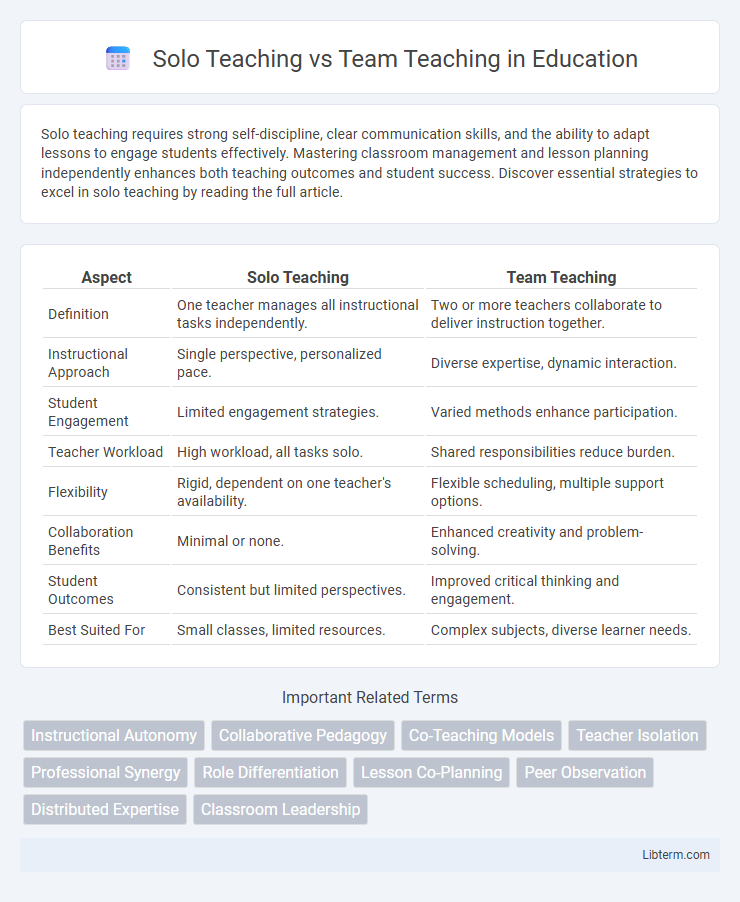Solo teaching requires strong self-discipline, clear communication skills, and the ability to adapt lessons to engage students effectively. Mastering classroom management and lesson planning independently enhances both teaching outcomes and student success. Discover essential strategies to excel in solo teaching by reading the full article.
Table of Comparison
| Aspect | Solo Teaching | Team Teaching |
|---|---|---|
| Definition | One teacher manages all instructional tasks independently. | Two or more teachers collaborate to deliver instruction together. |
| Instructional Approach | Single perspective, personalized pace. | Diverse expertise, dynamic interaction. |
| Student Engagement | Limited engagement strategies. | Varied methods enhance participation. |
| Teacher Workload | High workload, all tasks solo. | Shared responsibilities reduce burden. |
| Flexibility | Rigid, dependent on one teacher's availability. | Flexible scheduling, multiple support options. |
| Collaboration Benefits | Minimal or none. | Enhanced creativity and problem-solving. |
| Student Outcomes | Consistent but limited perspectives. | Improved critical thinking and engagement. |
| Best Suited For | Small classes, limited resources. | Complex subjects, diverse learner needs. |
Introduction to Solo Teaching and Team Teaching
Solo teaching involves an educator independently managing all aspects of the classroom, including lesson planning, instruction, and assessment, allowing for personalized control and flexibility. Team teaching features multiple educators collaborating to design and deliver lessons, combining diverse expertise and instructional styles to enhance student engagement and learning outcomes. Both approaches offer distinct advantages, with solo teaching emphasizing autonomy and team teaching promoting shared responsibilities and enriched educational experiences.
Key Differences Between Solo and Team Teaching
Solo teaching involves one educator managing all instructional responsibilities, enabling consistent delivery and individualized pacing tailored to student needs. Team teaching engages multiple educators collaborating in lesson planning, instruction, and assessment, fostering diverse perspectives and shared expertise that enhance student engagement and learning outcomes. Key differences include the level of collaboration, resource sharing, and flexibility in instructional methods, with solo teaching emphasizing autonomy and team teaching prioritizing coordinated efforts.
Advantages of Solo Teaching
Solo teaching offers educators full autonomy to design and implement lesson plans tailored specifically to their students' needs, fostering personalized learning environments. It enables seamless classroom management and consistent instructional delivery without the need for coordination with colleagues. This approach also allows for immediate adaptability during lessons, enhancing student engagement and responsiveness.
Benefits of Team Teaching
Team teaching fosters dynamic collaboration between educators, enhancing diverse expertise and instructional strategies that address varied student learning styles. This approach promotes increased student engagement and motivation by delivering richer, more interactive lessons that leverage multiple perspectives. Shared responsibilities reduce teacher burnout and create opportunities for continuous professional development through peer support and feedback.
Challenges in Solo Teaching
Solo teaching often presents challenges such as increased workload and limited opportunities for professional collaboration, which can lead to feelings of isolation and burnout. Teachers must independently manage lesson planning, classroom management, and student assessments without shared support. This solitary approach can also restrict diverse instructional strategies and peer feedback that team teaching typically provides.
Common Issues in Team Teaching
Team teaching often encounters challenges such as inconsistent communication and conflicting instructional styles, which can disrupt lesson flow and affect student engagement. Differences in planning time and assessment methods frequently lead to uneven workload distribution and misunderstandings among co-teachers. These issues impact the overall effectiveness of collaborative teaching environments, emphasizing the need for clear roles and ongoing dialogue.
Best Practices for Effective Solo Teaching
Effective solo teaching leverages clear lesson planning, dynamic classroom management, and individualized student engagement to optimize learning outcomes. Utilizing formative assessments regularly allows solo teachers to monitor progress and tailor instruction to diverse learning styles. Incorporating reflective practices and continuous professional development enhances instructional strategies and promotes student success in a single-teacher environment.
Strategies for Successful Team Teaching
Successful team teaching hinges on clear communication and collaborative planning to align instructional goals and methods among educators. Effective strategies include regular coordination meetings, shared assessment criteria, and leveraging each teacher's strengths to deliver diverse perspectives. Establishing mutual respect and adaptable roles ensures a cohesive learning environment that benefits students through dynamic and well-organized instruction.
Choosing the Right Approach for Your Classroom
Choosing between solo teaching and team teaching depends on class size, subject complexity, and student learning styles. Solo teaching offers clear authority and streamlined decision-making, ideal for structured environments and individual-focused lessons. Team teaching promotes collaboration, diverse expertise, and dynamic interaction, enhancing engagement in multidisciplinary or large classrooms.
Conclusion: Solo vs Team Teaching – Which is Better?
Solo teaching allows for complete control over lesson pacing and style, which can benefit educators who prefer autonomy and consistency. Team teaching fosters collaboration, diverse perspectives, and dynamic classroom interaction, enhancing student engagement and learning outcomes. Choosing between solo and team teaching depends on the teacher's adaptability, subject complexity, and the educational environment's support for cooperative approaches.
Solo Teaching Infographic

 libterm.com
libterm.com